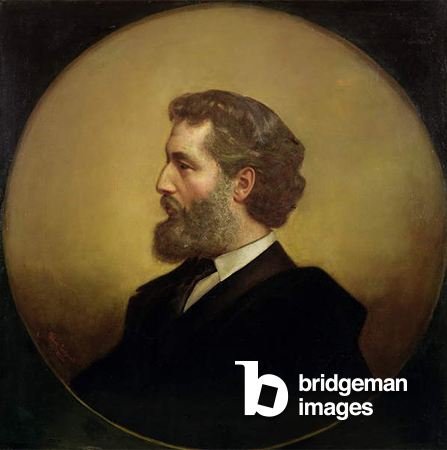Located on the edge of London’s Holland Park, Leighton House Museum is the former studio house of the great Victorian artist and sculptor Frederic, Lord Leighton (1830-1896).
Leighton House Museum reopens on October 15, 2022 after an £8m refurbishment, having completed a series of restorations and expansions to better accommodate the collection and welcome visitors.
As a mansion that combines living and studio space, the museum provides a unique insight into Leighton’s private world. It is a unique venue for the understanding and appreciating Victorian art and architecture. It now houses collections of essential paintings by Leighton and his contemporaries.
In this article, we will explore the gems hidden in the museum’s collection by diving deeper into the history of the house and the story of Frederic, Lord Leighton.
Discover all the images from the Leighton House Museum available on our website

History of Leighton House
Built in 1866 by architect George Aitchison with red Suffolk bricks and Caen stone dressings, this classical Victorian compound was expanded several times over the next 30 years, as per Leighton’s wishes to make more space for his collection.
During his lifetime, Leighton amassed an extensive collection of paintings, drawings, etchings, ceramics, and other artefacts. This versatile collection manifested his passion for art and his love of travel.
%2C%20Frederic%20Leighton%2C%20(1830-96)%20_%20Leighton%20House%20Museum%2C%20Kensington%20%26%20Chelsea%2C%20London%2C%20UK%20_%20%C2%A9%20Leighton%20House%20_%20Bridgeman%20Images.jpg)
After Leighton died in 1896, his entire collection was sold at an auction at King’s Street Christie’s and the house was deserted until the Leighton House was formed a year later. The collections at the museum today represent items that were initially in Leighton's possession and that have been retrieved by the museum over the past century.
%2C%20Dicksee%2C%20Frank%20(1853-1928)%20_%20Leighton%20House%20Museum%2C%20Kensington%20%26%20Chelsea%2C%20London%2C%20UK%20_%20%C2%A9%20Leighton%20House%20_%20Bridgeman%20Images.jpg)
Leighton’s Collection of Western Art
Born to a well-off medical family, Leighton was trained as an artist with first-hand observation of great works of art throughout Europe. This training and his observations developed into a passion for art and culture. He collected works by both historic artists and his contemporaries. Being the president of the Royal Academy of Arts, he was able to maintain a friendly artistic relationship with the artists of the Academy and those who had rejected it. The respectful friendship was reflected in his collection of works by Solomon Joseph Solomon, Frank Dicksee and more.
%2C%20Solomon%2C%20Solomon%20Joseph%20(1860-1927)%20_%20Leighton%20House%20Museum%2C%20Kensington%20%26%20Chelsea%2C%20London%2C%20UK%20_%20%C2%A9%20Leighton%20House%20_%20Bridgeman%20Images.jpg)
Leighton’s Travels to Europe
Travelling had been a vital part of Leighton’s life since he was young. He traveled widely around Europe with his family during his teenage years and spent his late teens in Frankfurt, Germany. He stayed in Rome and Paris for an extended period in his late twenties and produced numerous small sketches in oils as he traveled. These sketches provide a visual record of Leighton’s travels and showed his study and practice for various effects of light, color and landscape.
Leighton’s Collection of Islamic Art
There was a growing demand for Oriental artifacts in Europe at the time. Thus places such as Morocco, Algeria, Egypt and Turkey were hot travel destinations. Leighton’s first trip to Algeria in 1857 is probably the spark of his fondness for Islamic artifacts. He then traveled to North Africa and the Middle East frequently and acquired various objects from the Islamic world, including vases, tableware, textiles, metalwork, carpets, and woodwork.
%2C%20Morgan%2C%20William%20De%20(1839-1917)%20_%20Leighton%20House%20Museum%2C%20Kensington%20%26%20Chelsea%2C%20London%2C%20UK%20_%20%C2%A9%20Leighton%20House%20_%20Bridgeman%20Images.jpg)
His love for oriental artifacts led to the construction of his Arab Hall in 1877, which was inspired by a twelfth-century Arab-Norman palace named La Zisa in Palermo, Sicily.
Leighton House - Reopening on October 15, 2022
The museum is scheduled to reopen after an £8m refurbishment on October 15, 2022. The house has completed a series of restorations and expansions to better accommodate the collection and welcome visitors. An exciting addition to the museum is a mural by Iranian-born artist Shahrzad Ghaffari, decorating the curving stairwell in the new entrance hall. The peacock blue paint resonates with the blue tiles of the Arab Hall and accentuates the oriental tone of the space.
Discover many more images from the Leighton House Museum available on our website
Bridgeman Images helps thousands of brands, agencies, publishers and manufacturers find and license exactly the right imagery for their needs.
Get in touch to find out how we can do this for you.

%2C%20Leighton%2C%20Frederic%20(1830-96)%20_%20Leighton%20House%20Museum%2C%20Kensington%20%26%20Chelsea%2C%20London%2C%20UK%20_%20%C2%A9%20Leighton%20House%20_%20Bridgeman%20Images.jpg)
%2C%20Leighton%2C%20Frederic%20(1830-96)%20_%20Leighton%20House%20Museum%2C%20Kensington%20%26%20Chelsea%2C%20London%2C%20UK%20_%20%C2%A9%20Leighton%20House%20_%20Bridgeman%20Images.jpg)
%20(see%20also%20250631)%2C%20Aitchison%2C%20George%20II%20(1825-1910)%20_%20Leighton%20House%20Museum%2C%20Kensington%20%26%20Chelsea%2C%20London%2C%20UK%20_%20%C2%A9%20Leighton%20House%20_%20Bridgeman%20Images.jpg)
%20between%201866%20and%201895%3B%20Kensington%20%26%20Chelsea%2C%20London%2C%20UK%20(photo)%20_%20%C2%A9%20Leighton%20House%20_%20Bridgeman%20Images.jpg)


